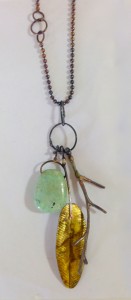Probably most jewelry artists dream of making one-of-a-kind pieces and think of production work as drudgery. However, production doesn’t have to be boring. It can be lively, interesting and innovative. However, like all your work, it requires marketing. If fact, your chance of success is reduced if you make a production line without considering the market you’re targeting. You need to know what your product is, how it’s different from others on the market, who your primary buyers are, where they buy jewelry like yours, how much they’ll pay, and how to get them to notice your product.
Jewelry artists usually gravitate to a certain selection of materials and techniques that they use to create their work. They may have a particular design voice, theme, or story to tell. For many, this is their starting point. They hope to find an audience to buy the work. Others start from the marketing end: Is there a particular audience or market opportunity they can fit their work to? However, audience and market are almost inextricably intertwined. It is really impossible to consider one without the other: product decisions affect marketing decisions; marketing decisions influence the product. Most jewelry artists go back and forth between the two as they create their lines.
For example, suppose your work is based on something you’re passionate about: old toys, animals, architecture. If your product has a strong identity, it will likely draw people who have the same interests. As a result, that affects how and where you sell your product.
Besides traditional gallery or art show venues, how might your jewelry fit a special interest market opportunity outside normal craft jewelry outlets? Could you sell it at cat, dog or horse shows, or zoos; science fiction, fantasy, steampunk, or graphic novel conventions; history re-enactment or historical society meetings; to hand-weaving, quilting or knitting groups?
For beginners, your business plan will almost assuredly include a strict budget. However, production means making a lot of pieces up front, without confirmed buyers. Not only must you invest time in the making, but the costs of the materials. If your business plan is to reach a large market, you may choose to work in silver, bronze, copper or bi-metals rather than gold in order to stay within your budget. If you want to go into lifestyle catalogs, you may even end up producing your line in pewter or plated components.
On the other hand, if your brand idea is based on reaching a high-end clientele with a taste for gold, you may not want to start with less expensive materials, but may be unable to afford producing the amount of work a wholesale show or large retailer demands in gold. In that case, you may opt to create a small line gold and target your marketing efforts to small, high-end boutiques. It may mean growing your business more slowly, but it will enable you to stay on brand.
It’s common for jewelry artists to start their businesses while working in another field and/or raising a family. Time is an issue. Making a production line enables them to fulfill their dream in the limited time available: before or after work, on the weekends, after the kids have gone to bed–even while watching TV! (Well-known jewelry artist, Ramona Solberg, used to twist and form her signature fibula pins while watching her favorite programs.) To get started quickly, these artists may find a potential market and decide what they can make, within their limited means, time and skills, to fit that market. That may be beading, beading and wire work, assembly from manufactured components.
Market, product. Product, market. The two are inseparable. How will you marry them?

